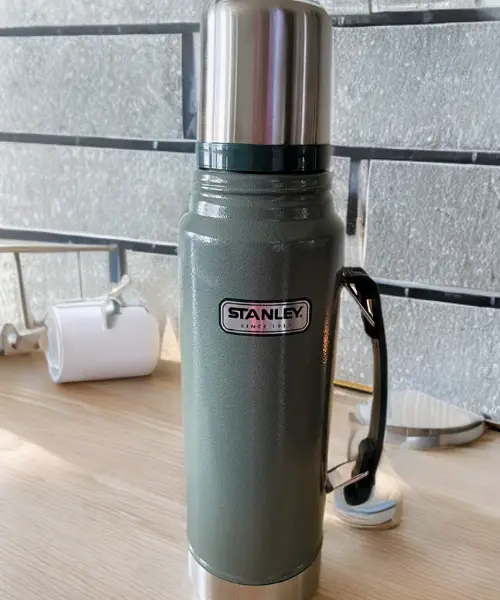In the hustle of our daily lives, having a hot meal ready when we are on the go can be a game-changer.
A good quality thermos can keep your food warm for several hours, offering the convenience of enjoying a warm meal without needing a microwave or stove.
When packing food, not all items are created equal. Rice, a staple in many diets worldwide, poses a unique question: can you safely put rice in a thermos?
Let’s look into the details of packing warm food, understanding heat retention in insulated containers, and the best practices for food storage to ensure you can enjoy a hot meal safely.

Understanding Heat Retention in Insulated Containers
Thermoses, or insulated containers, are designed to maintain the temperature of the contents inside by providing a barrier to heat transfer.
They work on the principle of vacuum insulation, where the space between two walls is devoid of air, minimizing the movement of heat. T
his technology is excellent for keeping your liquids hot or cold for extended periods. But when it comes to solid food like rice, there are additional considerations.
How a Thermos Works
To understand why certain foods maintain temperature better than others in a thermos, it’s important to know how these containers function.
A thermos reduces heat transfer through three modes: conduction, convection, and radiation.
By eliminating air (which is a conductor of heat) and reflecting radiant heat with a reflective coating, your food can stay at a desired temperature much longer than it would in a regular container.
Heat Retention of Different Foods And Safety Concerns
Not all foods have the same heat retention properties. Soup, for example, will stay hot longer than solid foods due to its liquid state, which allows heat to be distributed more evenly.
Solid foods like rice can lose heat more quickly because they have more surface area exposed to the cooler temperatures of the thermos walls.
Rice is a bit of a special case when it comes to food storage due to its potential to harbor Bacillus cereus, a bacterium that can cause food poisoning.
This bacterium can survive the cooking process, and if rice is left at room temperature for too long, it can grow and produce toxins that can make you sick.
The Risks of B. cereus in Rice
The spores of B. cereus are quite hardy and can survive even in hot temperatures.
These spores can germinate into bacteria, which multiply and produce toxins in rice that has been left out at room temperature for an extended period.
The danger is that reheating contaminated rice will not destroy the toxins, even if the bacteria are killed.
Best Practices for Rice Storage
To safely store rice in a thermos, you need to minimize the time it spends in the “danger zone” (between 40°F and 140°F, where bacteria grow most rapidly).
The rice should be steaming hot (above 140°F) when placed in the thermos, and the container should be preheated with boiling water to ensure maximum heat retention.
Preheat Your Thermos
Before adding rice, fill the thermos with boiling water, secure the lid, and let it sit for a few minutes.
This will heat the interior, ensuring that your food starts out at a temperature that’s less conducive to bacterial growth.
Make sure the rice is heated to a high temperature (above 165°F) before placing it into the thermos. This will help kill any bacteria that might be present.
After preheating the thermos and heating the rice, quickly transfer the rice into the thermos. Fill it to the top to reduce the amount of air space, which can accelerate heat loss, and secure the lid tightly.
Consume Within a Safe Time Frame
Even with a thermos, it’s best to consume the rice within a few hours. The longer the rice is stored, even in a thermos, the higher the risk of bacterial growth.
Additional Tips for Packing Hot Meals in a Thermos
Beyond rice, when packing any hot meal in a thermos, consider these tips to ensure your food stays warm and safe to eat.
Choose the Right Thermos
Not all thermoses are created equal. Choose a high-quality, vacuum-insulated container that is rated for holding food, not just liquids.
Consider Food Texture
Some foods retain heat better than others. A stew or chili, with a mix of liquid and solid components, will stay hot longer than drier foods. If you’re packing rice, consider mixing it with a sauce or gravy to help it retain heat.
Avoid Cross-Contamination
Always use clean utensils when packing food into your thermos to prevent introducing any bacteria that could lead to foodborne illness.
Thermos Alternatives for Keeping Rice Hot
If you’re concerned about the safety of storing rice in a thermos, there are alternative methods for keeping your rice hot.
Insulated Food Jars
Some insulated food jars are specifically designed for solid foods and may offer better heat retention for items like rice compared to traditional liquid thermoses.
Electric Lunch Boxes
An electric lunch box can plug into an outlet or your car’s power source to heat your rice safely, ensuring it stays out of the danger zone.
Microwaveable Heat Packs
For a non-electric option, consider using microwaveable heat packs that can be placed alongside your food container to provide additional warmth.
Conclusion
While putting rice in a thermos is possible, it requires careful attention to food safety practices to avoid the risk of foodborne illness.
By understanding the principles of heat retention in insulated containers and following the safety advice provided, you can enjoy a warm, delicious serving of rice even when you’re away from the kitchen.
Always prioritize safety by keeping your food at the correct temperatures and consuming it within a reasonable time frame.
